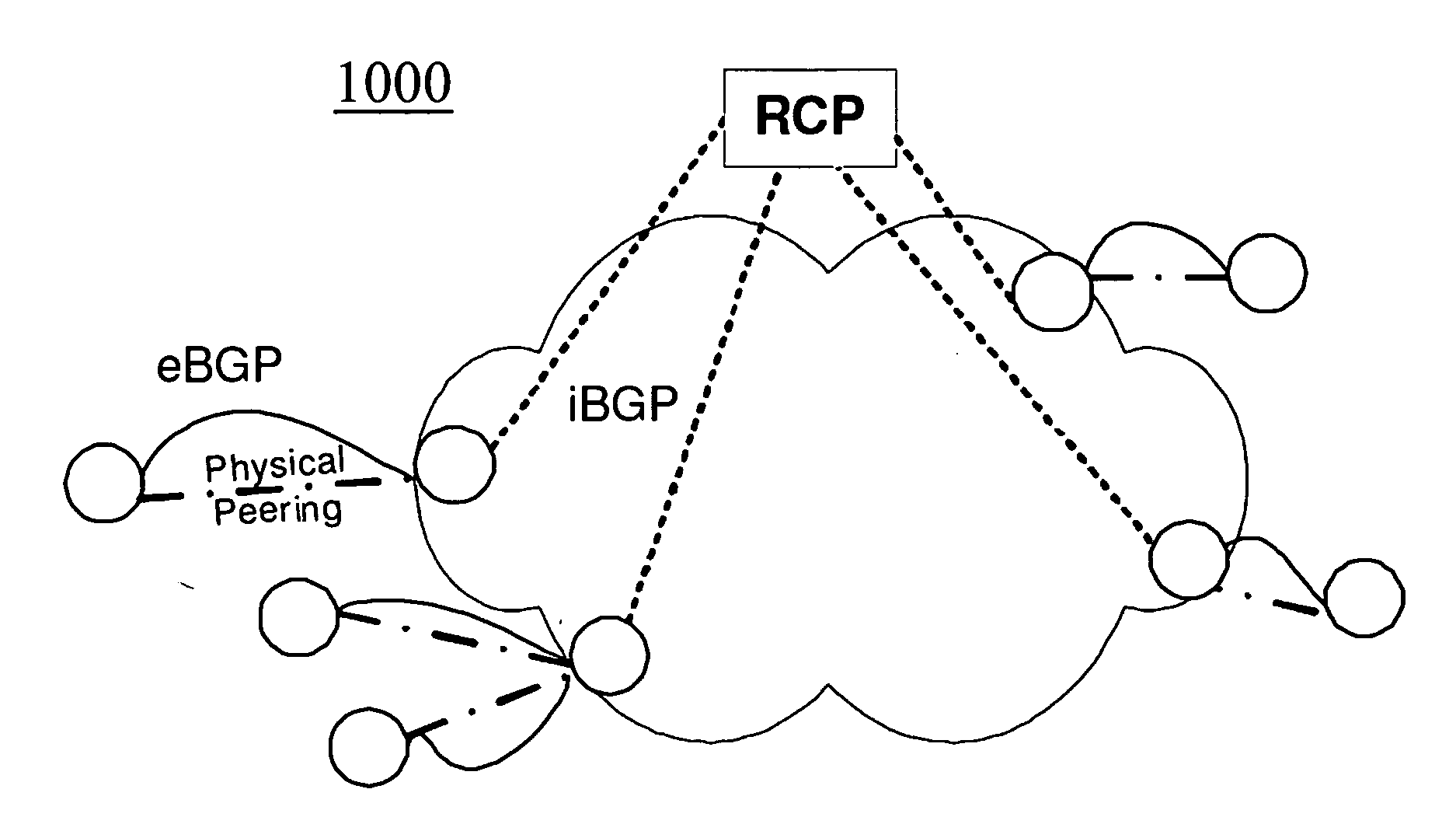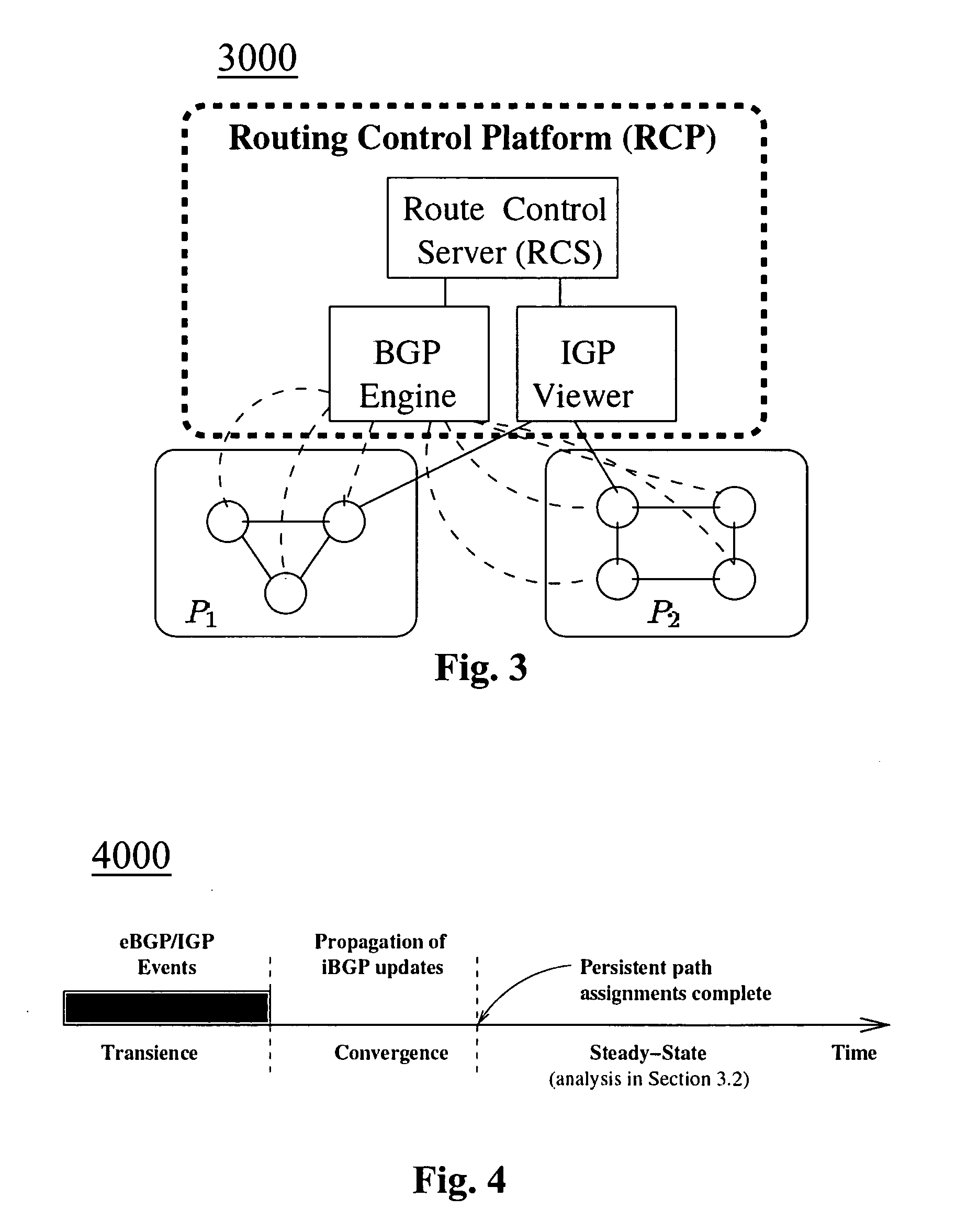Although having a faster processor and more memory on every
router would support larger full-mesh configurations, the
installed base of routers tends to
lag behind the technology curve, and upgrading routers can be quite costly.
In addition, BGP-speaking routers do not always degrade gracefully when their resource limitations are reached; for example, routers crashing or experiencing persistent routing
instability under such conditions have been reported (see reference 3).
Using
route reflectors can reduce the memory and / o connection overhead on the routers, at the expense of compromising the behavior of the underlying network.
In particular, a
route reflector does not necessarily select the same BGP route that its clients would have chosen in a full-mesh configuration.
Unfortunately, the routers along a path through the AS can be assigned different BGP routes from different route reflectors, leading to inconsistencies (see reference 5).
In addition, the network might experience long convergence delays because of the overhead on the routers to revisit the BGP routing decisions across many prefixes.
Although the IGP topology within an AS is typically a single
connected component, failures of links, routers, and / or interfaces might occasionally create partitions.
Here, we make a reasonable assumption that IGP
connectivity between two endpoints is sufficient to establish a BGP session between them; in reality, persistent congestion or misconfiguration could cause this assumption to be violated, but these two cases are anomalous.
These inconsistencies might be either transient or persistent and could create problems such as routing loops if routers were learning routes from different replicas.
If the AS uses an IGP to forward packets between ingress and egress routers, then inconsistent egress assignments along a single IGP path could result in persistent forwarding loops.
In this section, we discuss the nature and consequences of these inconsistencies and present the surprising result that no consistency protocol is necessarily required to prevent persistent inconsistencies.
During transient periods, routes might be inconsistent.
We note that certain failure scenarios might violate Observation 2; there may be circumstances under which IGP-level
connectivity exists between the BGP engine and some
router but, for some reason, the iBGP session fails (e.g., due to congestion, misconfiguration,
software failure, etc.).
As a result, Observation 3 might be overly conservative, because there might exist routers in some partition for which two RCS's might have BGP routing information from different subsets of routers in that partition.
In this case, not having a consistency protocol affects
liveness, but not
correctness; in other words, two or more RCS's might fail to assign routes to routers in some partition even when they collectively have complete routing information, but in no case will two or more RCS's assign different routes to the same
router.
Scalability and efficiency
pose the main challenges, because backbone AS's typically have many routers (e.g., 500-1000) and destination prefixes (e.g., 150,000-200,000), and the routing protocols typically must converge quickly.
Finding the routes that are affected can be an expensive process and as shown in FIG. 5, our design uses a path-cost based
ranking of egress routers to perform this efficiently.
Unfortunately, this optimization cannot be used for BGP announcements, because when a new route arrives, the RCS must recompute the
route assignment for each router.
However, it does not learn the entire topology of remote areas (i.e., the areas in which the router does not have links), but instead learns the total cost of the paths to every node in remote areas from each border router the area has through “summary” LSAs.
As expected, the
message passing adds some overhead to the
processing times. The difference between the two blackbox results are due to the bursty arrival nature of the BGP updates, which produces a queuing effect on the RCS.
Second, the SPF calculation and
path cost change steps are the main contributors to the
processing time.
This result highlights the difficulty in
processing internal topology changes.
Although our RCP prototype handles BGP update messages very quickly, processing the internal topology changes introduces a significant challenge.
The problem stems from the fact that a single event (such as a link failure) can change the IGP path costs for numerous pairs of routers, which can change the BGP route assignments for multiple routers and destination prefixes.
The vendors of commercial routers also face challenges in processing the many BGP routing changes that can result from a single IGP event.
The router can be configured to scan the BGP
routing table more frequently, at the risk of increasing the processing load on the router.
RCP arguably faces a larger challenge from hot-potato routing changes than a conventional router, since RCP can and / or must compute BGP routes for multiple routers.
Although optimizing the
software would reduce the time for RCP to respond to path-cost changes, such enhancements cannot make the problem disappear entirely.
 Login to View More
Login to View More  Login to View More
Login to View More 


